Straight Facts on Angels
- Details
- Written by AndEl
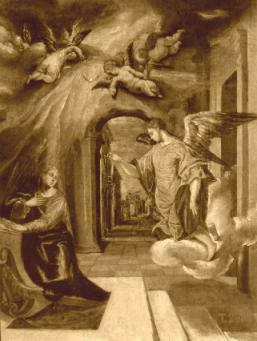 What's the deal with angels?
What's the deal with angels?
As I'm delving further into the Old Testament, I'm noticing something - I recall a tradition (probably Catholic, so correct me if I'm wrong) regarding the ranks of angels, cherubim, seraphim, and so on. If there's rank in heaven, then this implies inequality in the spirit world, and while we're at it, if archangels are the warriors (I know St. Michael is up there) then this would imply the good angels would have to PHYSICALLY FIGHT demons to get them out of heaven. Granted I haven't gotten very far into the scriptures yet, but I'm wondering where these traditions came from since I haven't seen them mentioned yet. While I don't expect the definitive answer on this, perhaps you can tell me how and why these traditions got started and who started them. Just how do angels and demons allegedly get their stripes? What is the order of ranks among the angels? — Just Curious, Ted December 24, 2002
Answer:
Seeing as it's Christmas Eve, I bet you're also going to want to know about the famous angel Hark, as in, "Hark, the herald angel, sings." Patience, lad. All will be explained in the fullness of time. Actually, we're going to try to give the answer to "where does it all come from." The first thing you should know is that the development of modern angels has been an evolutionary process. If you're searching through the Old Testament for an angel along the lines we know today (wings, halo, harp, Michael Landon look-alike), forget it. The concept of angels has changed considerably since ancient times. Second, angels play very different roles in Christianity, Judaism and Islam. And third, while angels appear in both the Old and New Testaments, most of the ancient detail we have about angels is NOT biblical, but instead comes from the apocrypha (books written before 100 BC that were rejected from inclusion in the Old Testament) and the pseudepigrapha (books written from 200 BC to 100 AD that were never considered for inclusion in the canonical Bible).
For information on how books were included or excluded from the Bible, see the Staff Report "Who wrote the Bible? (Part V)" at www.straightdope.com/mailbag/mbib le5.html. This topic is a vast one, and we can give only a brief (although still long) overview here.
Etymology and Definition
The most common Hebrew word for angel is malakh, really meaning "messenger." The plural is malakhim. NOTE: The -im ending, which you will see a lot in this report, pluralizes, so one cherub, two cherubim. The Arabic word for angel is malak, derived from the Hebrew. The English word "angel" derives from the Sanskrit angiras through the Greek angelos ("messenger"). However, there were several other terms used in ancient Hebrew to refer to heavenly beings, such as cherubim, elohim ("gods") and bene elohim ("sons of God" or "sons of gods") or metaphors like "chariots of God."
What is an angel?
In the earliest Biblical books, angels are merely servants or messengers, running errands for God, including jobs such as guardians, counselors, judges, warriors, matchmakers, gravediggers, and cooks. By the Middle Ages and after, angels are some sort of supernatural being, an intermediary between God and man. Angels are members of heavenly choirs, they sit around the throne of judgment, and they deliver messages of prophecy or doom. They fight battles and inspire hope. They do miracles and save Jimmy Stewart's Christmas.
What do angels look like?
 That's changed a lot over time. Since angels are (presumably) spiritual beings rather than material beings, they (also presumably) would not have physical bodies. However, the authors, prophets, and poets who first wrote about angels in biblical times did not know how to describe invisible spirits except in anthropomorphic terms - that is, they depicted the angels as human. For example, Abraham sees three men approaching (Genesis 18:2) who turn out to be angels bringing messages, and King Nebuchadnezzar (Daniel 3:25) sees four men in the fiery furnace when he only threw in three, and Acts 1:10 mentions "two men in white who stood by" at Jesus'' tomb. So, the bible reports angels that can be easily mistaken for humans, usually males. Female angels (and demons), such as Lilith (see Staff Report at www.straightdope.com/mailbag/mlilith.html) were few and far between. Note that these earliest angels do not have wings. In Genesis 28:12, Jacob dreams of a ladder reaching to the sky, and angels "going up and down on it" - they didn't fly.
That's changed a lot over time. Since angels are (presumably) spiritual beings rather than material beings, they (also presumably) would not have physical bodies. However, the authors, prophets, and poets who first wrote about angels in biblical times did not know how to describe invisible spirits except in anthropomorphic terms - that is, they depicted the angels as human. For example, Abraham sees three men approaching (Genesis 18:2) who turn out to be angels bringing messages, and King Nebuchadnezzar (Daniel 3:25) sees four men in the fiery furnace when he only threw in three, and Acts 1:10 mentions "two men in white who stood by" at Jesus'' tomb. So, the bible reports angels that can be easily mistaken for humans, usually males. Female angels (and demons), such as Lilith (see Staff Report at www.straightdope.com/mailbag/mlilith.html) were few and far between. Note that these earliest angels do not have wings. In Genesis 28:12, Jacob dreams of a ladder reaching to the sky, and angels "going up and down on it" - they didn't fly.
Halos and harps also came much later in the evolution of angels. Other later, more poetic mentions of angels, for example in some of the books of Prophets, offer very different descriptions. Isaiah 6:2 describes angels with six wings, each pair having its own function - two to cover his face, two to cover his feet (read: genitals) and two to fly. Ezekiel has a vision of angels with six wings and multiple faces (1:6ff), and also of angels as fiery wheels, or thrones, with many eyes (1:15ff). The variety of descriptions led scholars and theologians to conclude that there were several kinds of angels. After all, a huge creature with six wings and four faces would not be mistaken for a human by anyone, let alone Abraham. Hence, there must be different classes or species of angels, even fallen angels (devils and demons being merely classes of angel).
By the Middle Ages, the number of species and the ranks of angels were being hotly debated. Cecil wrote about this in "Did medieval scholars argue over how many angels could dance on the head of a pin?" at ww.straightdope.com/classics/a4_13 2.html.
Thomas Aquinas's lectures in 1259 set down everything known about angels, reasoning from scriptural and extra-scriptural sources. Aquinas concluded that angels were intellect, not matter, animals without bodies who can assume bodies at will, who eat and drink and appear among mankind. Aquinas also fixed the hierarchy of angels, and his pronouncements have prevailed in Christianity for three-quarters of a millennium. But more on this later.
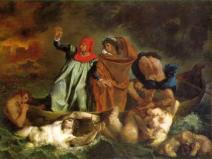
A few decades later, around 1320, the Italian poet Dante Alighieri followed the hierarchy set forth by Aquinas in the Divine Comedy, with definitive rankings and poetic descriptions of all the heavenly creatures, both good and evil. Dante mostly wrote of angels as transcendent beings of light and song. By the Renaissance, Martin Luther (1463-1546) referred to angels as "guides." However, Protestants generally didn't pay much attention to angels. John Calvin (1509-1564) called writings about the angelic hierarchy "the vain babblings of idle men" and deplored such speculations as fruitless and unprofitable. (Ha!) In 1664, the English poet John Milton wrote Paradise Lost. He ignored Aquinas's angelic order and orthodox tradition - he was English, after all. Milton's angels were basically non-corporeal humans, who ate and drank and had sex (yep, sex!).
Today angels are part of the tradition of at least four world religions - Zoroastrians, Christians, Jews, and Muslims.
Literary History
Supernatural beings who visit earth did not begin with the bible, of course. Over a thousand years before the first biblical texts were written, the ancient Sumerians carved winged figures descending from the first of their seven heavens to pour water into the cup of the king.
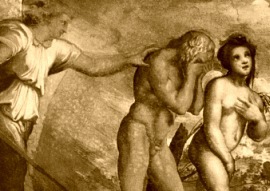 In the earliest Biblical books, angels appear infrequently, and then primarily as messengers, running errands for God. As noted, they usually appear as men, but not always. The first biblical appearance in Genesis 3:24 says cherubim with a flaming sword were set to prevent access to the Tree of Life after Adam and Eve were expelled from the Garden of Eden. (For a description of cherubim, see below.) In the Pentateuch, various angels prevent Abraham from sacrificing Isaac, direct Hagar to water in the desert, protect Lot, destroy Sodom, and harden Pharaoh's heart, among other deeds. These angels are anonymous and not described. Through the later Old Testament books of Judges and Kings, angels inspire military leaders (Judges 6:11) and destroy armies (II Kings 19:36).
In the earliest Biblical books, angels appear infrequently, and then primarily as messengers, running errands for God. As noted, they usually appear as men, but not always. The first biblical appearance in Genesis 3:24 says cherubim with a flaming sword were set to prevent access to the Tree of Life after Adam and Eve were expelled from the Garden of Eden. (For a description of cherubim, see below.) In the Pentateuch, various angels prevent Abraham from sacrificing Isaac, direct Hagar to water in the desert, protect Lot, destroy Sodom, and harden Pharaoh's heart, among other deeds. These angels are anonymous and not described. Through the later Old Testament books of Judges and Kings, angels inspire military leaders (Judges 6:11) and destroy armies (II Kings 19:36).
After the Babylonian captivity (mid 500s BC), the prophets and Hebrew authors drew a great deal of imagery from Babylonian and Persian culture. In the last-written books of the Old Testament, such as Daniel, Chronicles and Ezekiel, angels became a bit more prominent but remained unnamed and without distinctive identities. There are two (or three) exceptions: * In the Book of Daniel, Michael and Gabriel are specifically named as two angels, called "watchers." * There is mention of the satan in the Old Testament books of Job, Chronicles, Psalms, and Zechariah. As discussed in the Staff Report on Job (www.straightdope.com/mailbag/mjob.html), the satan is the Adversary, a prosecutor who brings charges. It was the title of a job or an office, NOT the name of an angel. More on this later. * Raphael appears in the book of Tobit, accepted in the Catholic Bible, but considered apocryphal by Protestants and Jews.
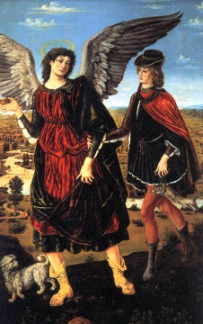
Most of these writings were rejected from the biblical canon. The apocalyptic Book of Revelation was included in the Christian Bible, and is full of poetry about angels. For example, Revelation 8:2 describes "the seven angels who stand before God; and to them were given seven trumpets." One of the earliest sources of angelology carried to extreme is the intertestamental "Book of Enoch," especially chapters 40 and 69. Of the two major religious/political parties in Jerusalem at the time of Jesus, the Sadducees thought that angels didn't exist, but were only human fancies or fantasies. The Pharisees, on the other hand, believed in angels. By the time of the New Testament (say, about 80 to 200 AD), many angels were named and personified. Angels rescue Peter from prison, announce to Mary that she is pregnant, comfort Jesus after the temptation of Satan, roll the stone from the tomb, etc. etc.
It was difficult for the early Church to deal with angels. Interest in angels, and even worship of angels, sprang from the peasants, arising from polytheistic folk worship, and was viewed as a threat to worship of Christ. For example, in Colossians 2:18, Paul himself warned that groveling to angels is wicked. Early Church theologians in the third and fourth centuries, like Eusebius and Theodoret, condemned the worship of angels. A Church council at Laodicea (343 BC) condemned angel-worship as idolatrous. But only a few decades later, St Ambrose suggested it was OK for Christians to "pray to the angels, who are given to us as guardians." You can't fight the grassroots. At the Second Council of Nicaea (787 AD), the Church reversed itself and the limited worship of angelic beings was formally approved.
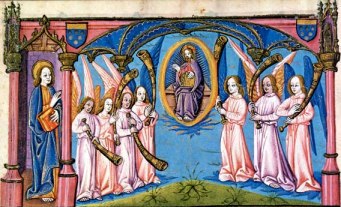
For the next several centuries, scholars identified, wrote about, and classified angels. Angelogy went amok in the 11th through 13th centuries. Jewish mystics (kabbalists) and Christian scholars named angels, created hierarchies, and determined sub-orders within hierarchies. The quantity of literature is staggering. Davidson suggests that angels were invented by (1) mixing some letters of the Hebrew alphabet, often through an anagram or acronym; and (2) adding the term -el (meaning "of God") or -irion to the end. Thus Hod ("splendor") became Hodiel ("Splendor of God"). Gevurah ("strength") became Gevurael, Cherubiel became the eponymous leader of the order of cherubim and Seraphiel ditto of the seraphim. The names of hundreds of angels were created in this fashion. Greek, Babylonian, Persian, and Roman gods and heroes became angels. The Greek god Hermes became the holy Hemesiel and Nergal the Akkadian lord of the underworld became the angel Nasargiel. Angels appeared in religious and secular literature, and some achieved canonical status.
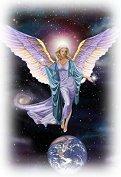
Orders and Hierarchies
The number of angels thought to exist has always been enormous - there were armies and legions. Daniel 7:10 and Revelation 5:11 both mention "thousands upon thousands." Depending on which authority you prefer, there were from 100,000 to 49 million angels.
By the Middle Ages, there were angels who governed the four seasons and the twelve signs of the zodiac and the 28 phases of the moon and the seven days of the week and each of the 24 hours of the day. Each of the seven planets had several angels. There were 64 angels who guarded the seven celestial halls of heaven. Burnham quotes St Augustine saying that angels "bred like flies," and adds, "No wonder they were divided into a hierarchy as strict as feudal lords."
There were many different ideas of how the hierarchy worked. St. Ambrose (340?-397 AD) and St. Jerome (340?-390 AD) each set forth angelic hierarchies. The critical work, however, was written in the 5th century and attributed to Dionysius the Areopagite. It was a forgery. Dionysius the Areopagite was a first century Greek, converted by St. Paul in Athens (Acts 17:34). So, our mystic writer is called pseudo-Dionysius to avoid confusion. One of the four mystic books by the pseudo-Dionysius was about the nature of angels, and provided what has become the orthodox Christian ordering of angels. Pseudo-Dionysius described nine orders in the celestial hierarchy, thus three choruses of three orders each (very neat, and note the use of the magic number three, thrice.) Other "authoritative" lists gave seven, nine, or twelve orders, including some fairly obscure species (ardors, sancitites, regents, apparitions, acclamations, gonfalons, warriors, etc.) and shuffled the order. The question of which angel goes in what order, and who heads which order, and similar questions were hotly disputed among the different authorities.
By the mid-1200s, Thomas Aquinas thought angelic hierarchies were important enough and confusing enough to be straightened out and included in his Summa Theologica. Aquinas accepted the order of the pseudo-Dionysius, and that has pretty much been official Catholic dogma ever since. And so the official list for Christians is:
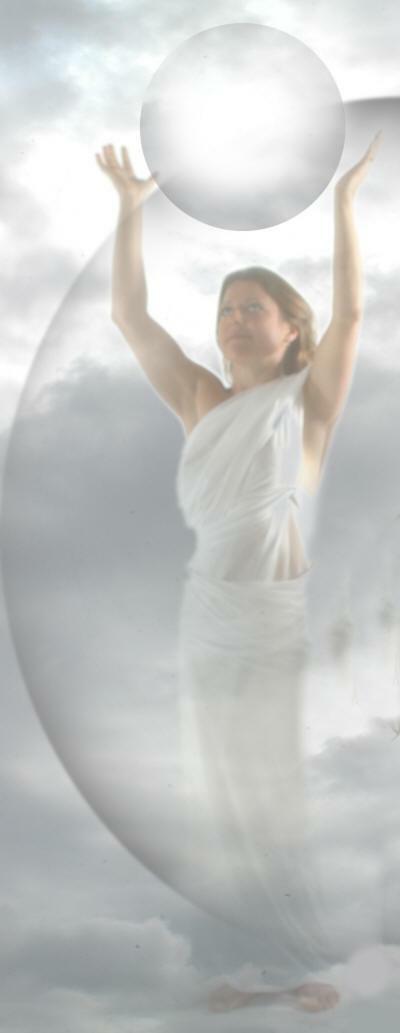 Seraphim
Seraphim
Cherubim
Thrones
Dominations (sometimes translated as dominions)
Virtues
Powers
Principalities
Archangels
Angels
If you're curious, St. Ambrose had a reverse order for thrones and dominations, and put principalities, then powers, then virtues respectively in the 5th, 6th, and 7th slots. St. Jerome had only seven orders, with powers, dominations, and thrones respectively in the 3rd, 4th, and 5th places, and dropping principalities and virtues.
Naturally, Jewish thinkers had a different hierarchy. There were basically two, one proposed by Moses Maimonides (1135 1204), one of the great rationalist religious thinkers; and the other in the Zohar, the great work of Jewish mysticism, published around 1275 although with much earlier roots.
Moses Maimonides' list:
Hayyoth ha-Qadesh
Ophanim
Erelim (thrones)
Chashmalim (dominations)
Seraphim
Malakhim (virtues)
Elohim
Bene Elohim
Cherubim
Ishim
The Zohar list:
Malakhim (virtues)
Erelim (thrones)
Seraphim
Hayyoth (cherubim?)
Ophanim
Hamshalim
Elim
Elohim
Bene Elohim
Ishim
If you try to reconcile the Christian and the Jewish hierarchies, you'll get a headache. Dominations are often equated with the hamshalim, thrones with the erelim or ophanim, and the virtues with the malakim. But the whole mess is very confusing, and exact reconciliation isn't possible.
Islam has completely different hierarchies. Based on cues from the Quran and the Hadith, angels are classified as bearers of the throne, cherubim (al-karrubiyan), angels of the seven heavens, guardian angels, attendant angels, journeying angels (sayahun) and generalized angels who help keep things on the right path, among others.
Orders of Angels Described
OK, so those are the hierarchies, but what the hell - er, what in heaven's name do they mean? The classes aren't just made up out of whole parchment, at least not entirely. For example, cherubim and virtues (malakhim) are specifically mentioned in the scripture of all three religions discussed here (Hebrew Bible, Christian Bible, and Quran.) As another example, Colossians 1:16 mentions "dominions or principalities or powers," and these were assumed to be angels. Basically, for each religion, each species of angel is derived from some line of Scripture - in some cases stated plainly, in others perhaps derived from an obscure verse given a certain spin. Here are descriptions of the primary classes:
Seraphim
The seraphim surround the throne of God and incessantly sing "Holy, holy, holy!" (Must be boring work.) They are angels of love, light, and fire. The only Old Testament reference to seraphim is Isaiah 6:2, where they have four faces and six wings (although some take Numbers 21:6 reference to "fiery serpents" to mean seraphim). In rabbinical writings, they are sometimes equated with hayyoth. There is no direct mention of seraphim in the New Testament or Quran.
Cherubim
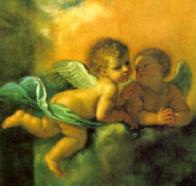 The modern notion of a cherub is a chubby naked infant with cute little wings. But the origin of the cherubim was quite different. Both the name and the description are Assyrian or Akkadian, where the karibu were depicted as huge winged creatures with human faces, the bodies of lions or bulls, and the wings of eagles. Think of griffins or winged sphinxes. Huge carvings of such beasts were placed at the entrance to temples or palaces. To the early Canaanites, these were not angels but horrible beasts. A cherub with a flaming sword guards the entrance to the Garden of Eden (Genesis 3:22). In the book of Exodus, two cherubim are sculpted of gold and set atop the Ark of the Covenant, and in I Kings 6:23, two cherubim in Solomon's temple are carved of olivewood. Ezekiel (10:14) describes cherubim as having four faces and four wings and many eyes, as does the apocryphal book of Enoch. Revelation 4:8 says they have six wings. In rabbinic and mystic Jewish lore, cherubim were the charioteers of God, carrying his throne. The Hebrew hayyoth (holy, heavenly beasts) are usually equated with the cherubim. According to the Zohar, they uphold the universe. Christian mystics say they guard the fixed stars. In the Quran, they are el-karrubiyan, who praise God night and day unceasingly. Early Muslim lore says the cherubim were created from the tears that the Archangel Michael shed over the sins of the faithful. Somehow, over time, the popular imagination turned these great beasts into the winged infants that decorate Hallmark cards and Disney films. Fascinating.
The modern notion of a cherub is a chubby naked infant with cute little wings. But the origin of the cherubim was quite different. Both the name and the description are Assyrian or Akkadian, where the karibu were depicted as huge winged creatures with human faces, the bodies of lions or bulls, and the wings of eagles. Think of griffins or winged sphinxes. Huge carvings of such beasts were placed at the entrance to temples or palaces. To the early Canaanites, these were not angels but horrible beasts. A cherub with a flaming sword guards the entrance to the Garden of Eden (Genesis 3:22). In the book of Exodus, two cherubim are sculpted of gold and set atop the Ark of the Covenant, and in I Kings 6:23, two cherubim in Solomon's temple are carved of olivewood. Ezekiel (10:14) describes cherubim as having four faces and four wings and many eyes, as does the apocryphal book of Enoch. Revelation 4:8 says they have six wings. In rabbinic and mystic Jewish lore, cherubim were the charioteers of God, carrying his throne. The Hebrew hayyoth (holy, heavenly beasts) are usually equated with the cherubim. According to the Zohar, they uphold the universe. Christian mystics say they guard the fixed stars. In the Quran, they are el-karrubiyan, who praise God night and day unceasingly. Early Muslim lore says the cherubim were created from the tears that the Archangel Michael shed over the sins of the faithful. Somehow, over time, the popular imagination turned these great beasts into the winged infants that decorate Hallmark cards and Disney films. Fascinating.
Thrones
These are the seven angels (although one Jewish legend says there are 70) who stand before the heavenly throne. They are derived from Ezekiel 1:15ff, a vision of angels as wheels with many eyes, hovering around the fixed point of God. They have four faces (lion, ox, eagle, and man) and four wings, and horses' hooves, and they sparkle like brass. I've always wondered what Ezekiel was smoking. Their dominant virtue is steadfastness, and their missions are related to bringing heavenly justice to earth. The Hebrew equivalent is erelim or ophanim. The cherubim are the charioteers of God, but the ophanim seem to be the actual chariots. The Quran refers to similar beings who will "carry above them the Throne of the Lord" (LXIX, 15-17.)
Dominations or Dominions
Their primary task is to regulate the duties of other angels; through them, the glory of God is manifested. For Christians, Zacharael is usually the prince or head of this order. They carry scepters or orbs as emblems of their power. In Hebrew lore they are probably the hashmallim, and chief of the order is Hashmal or Zadkiel.
Virtues
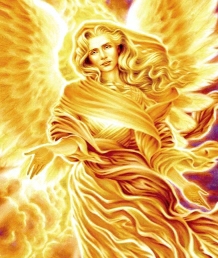 The Hebrew equivalent is malakhim, messengers. The word virtue derives from the Latin virtu meaning strength or excellence, and doesn't have the simpering modern connotation of being nice. These are the angels who do miracles on earth and are the chief bestowers of grace and valor. They often are associated with heroes and those who struggle for good. Matthew 18:10 mentions guardian "angels in heaven" and these are traditionally regarded as belong to the order of virtues. The two angels of the Ascension are also considered virtues; Acts 1:10 mentions "two men in white who stood by" and Eusebius says, "The Virtues of Heaven, seeing Him rise, surrounded him to form his escort."
The Hebrew equivalent is malakhim, messengers. The word virtue derives from the Latin virtu meaning strength or excellence, and doesn't have the simpering modern connotation of being nice. These are the angels who do miracles on earth and are the chief bestowers of grace and valor. They often are associated with heroes and those who struggle for good. Matthew 18:10 mentions guardian "angels in heaven" and these are traditionally regarded as belong to the order of virtues. The two angels of the Ascension are also considered virtues; Acts 1:10 mentions "two men in white who stood by" and Eusebius says, "The Virtues of Heaven, seeing Him rise, surrounded him to form his escort."
Powers
The powers keep demons from overthrowing the world. Think of border guards, patrolling the paths of Heaven on the lookout for diabolical infiltrators. Another take on it is that the powers preside over the demons. According to Paul in Ephesians 6:12, the powers are themselves evil. The largest number of defections of angels seems to come from the powers.
Principalities
These angels were originally in charge of nations and great cities on earth, but the category became vague, and they are now viewed as protectors of religion.
Archangels
Archangels are the messengers, bearing divine decrees. The term archangel is a bit confusing, since it is next to the lowest in the hierarchy, but the greatest angels are called archangels. For instance, in the Book of Daniel, Michael is called "one of the chief princes" meaning one of the archangels. In the New Testament, the term archangel occurs only twice. Revelation 8:2 mentions "seven angels who stand before God," and these are usually taken to be the seven archangels. The apocryphal book of Enoch names the seven as Uriel, Raguel, Michael, Seraqael, Gabriel, Haniel, and Raphael. Other lists appear in other apocrypha and pseudepigrapha. In other sources, we find twelve archangels, associated with the zodiac, or four. The Quran recognizes four archangels but names only two: Gabriel (Jibril in Arabic) the angel of revelation, and Michael (Mika'il in Arabic) the warrior angel who fights the battle of the faithful. Islamic tradition names the other two archangels as Azrael the angel of death and Israfel the angel of music who will sound the trumpets on the day of judgment.
Four of the Most Famous Angels
While we're at it, and since you mentioned Michael, here are four of the most commonly referenced angels. We have deliberately NOT given a full list of deeds, since there is no general agreement on which angel wrestled with Jacob or rolled away the stone from Jesus' tomb.
Michael
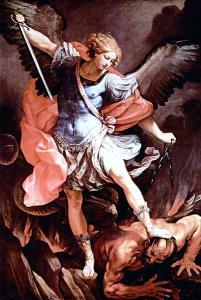 The name Michael means "Looks like God" or "Who is as God." Interestingly, all three religions (Christianity, Judaism, and Islam) recognize Michael as the greatest of the angels. Originally, he probably was a minor Chaldean god, incorporated into monotheism as an angel. He is chief of the virtues as well as the Archangels, connected with repentance, righteousness, mercy, and holiness. He is identified with the angel who destroyed the army of Sennacherib (although Uriel, Gabriel, and Ramiel have also been credited). Some authorities say he is the angel who held Abraham back from sacrificing Isaac, although others attribute this to Metatron, Tadhiel, and others. Michael saved Daniel's friends from the fiery furnace, was the intermediary between Mordecai and Esther, destroyed Babylon, etc. Jews see Michael as the "viceroy of heaven." Among the Dead Sea Scrolls, there is a scroll that describes "The War of the Sons of Light against the Sons of Darkness," with Michael leading the angels of light. In Christian iconography, Michael is usually depicted as young, strong, and handsome, with wings, and carrying an unsheathed sword, the warrior of God. In Renaissance paintings, he usually wears armor. He holds scales of justice, as he is one of the angels assigned to the final reckoning. Building on Revelation 12 ("war in heaven"), he is represented as leader of the armies of heaven against Satan. Michael is often depicted as standing with a spear over the defeated Satan, with Satan often in dragon form. Christians connect Michael with the angel of death, in the sense of deliverance and immortality. Christian folklore has him as the angel who rescued Peter from prison. In Arabic, he is called Mika''il and is mentioned by name in the Quran. In Islamic legend, the cherubim are created from tears that Michael shed over the sins of the faithful.
The name Michael means "Looks like God" or "Who is as God." Interestingly, all three religions (Christianity, Judaism, and Islam) recognize Michael as the greatest of the angels. Originally, he probably was a minor Chaldean god, incorporated into monotheism as an angel. He is chief of the virtues as well as the Archangels, connected with repentance, righteousness, mercy, and holiness. He is identified with the angel who destroyed the army of Sennacherib (although Uriel, Gabriel, and Ramiel have also been credited). Some authorities say he is the angel who held Abraham back from sacrificing Isaac, although others attribute this to Metatron, Tadhiel, and others. Michael saved Daniel's friends from the fiery furnace, was the intermediary between Mordecai and Esther, destroyed Babylon, etc. Jews see Michael as the "viceroy of heaven." Among the Dead Sea Scrolls, there is a scroll that describes "The War of the Sons of Light against the Sons of Darkness," with Michael leading the angels of light. In Christian iconography, Michael is usually depicted as young, strong, and handsome, with wings, and carrying an unsheathed sword, the warrior of God. In Renaissance paintings, he usually wears armor. He holds scales of justice, as he is one of the angels assigned to the final reckoning. Building on Revelation 12 ("war in heaven"), he is represented as leader of the armies of heaven against Satan. Michael is often depicted as standing with a spear over the defeated Satan, with Satan often in dragon form. Christians connect Michael with the angel of death, in the sense of deliverance and immortality. Christian folklore has him as the angel who rescued Peter from prison. In Arabic, he is called Mika''il and is mentioned by name in the Quran. In Islamic legend, the cherubim are created from tears that Michael shed over the sins of the faithful.
Satan (Samael)
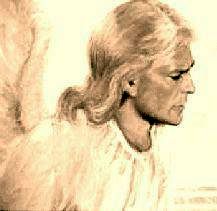 As noted above, the satan in the Old Testament is neither evil nor fallen; the Old Testament has no fallen angels, and classical Judaism rejects the possibility of angels rebelling against God. The satan in Job is not evil, but is an obedient servant of God, fulfilling his responsibilities of accusing. In Numbers 22:22, an angel of the Lord stands against Balaam "for an adversary." There is one instance (I Chronicles 21) where satan is mentioned without the definite article, but this generally accepted as a scribal oversight. By the time of the New Testament and later apocryphal writings, however, satan is clearly a person (or being) named Satan (or Samael, although some sources distinguish Samael as the angel of death and different from Satan.) Satan thus evolved from an obedient servant to a cast-out and rebellious enemy, the devil incarnate, who opposes God's will. Apocryphal books such as Enoch II name him as the prince of demons. Revelation 12 describes Satan as a "great dragon." Medieval writers around the 1100s tried to establish Satan's presence in the Old Testament, positing that Satan/Samael was disguised as a serpent to tempt Eve. Satan often appears in paintings as a serpent or dragon. Before his fall, Satan is generally considered to have been chief of the seraphim and virtues, but Aquinas says Satan was a cherub. Both cabalistic and Christian mystics say that Satan will be restored to his original rank in time. Satan is often mistakenly identified with Lucifer, due to a misreading of Isaiah 14:12, which actually refers to Nebuchadnezzer.
As noted above, the satan in the Old Testament is neither evil nor fallen; the Old Testament has no fallen angels, and classical Judaism rejects the possibility of angels rebelling against God. The satan in Job is not evil, but is an obedient servant of God, fulfilling his responsibilities of accusing. In Numbers 22:22, an angel of the Lord stands against Balaam "for an adversary." There is one instance (I Chronicles 21) where satan is mentioned without the definite article, but this generally accepted as a scribal oversight. By the time of the New Testament and later apocryphal writings, however, satan is clearly a person (or being) named Satan (or Samael, although some sources distinguish Samael as the angel of death and different from Satan.) Satan thus evolved from an obedient servant to a cast-out and rebellious enemy, the devil incarnate, who opposes God's will. Apocryphal books such as Enoch II name him as the prince of demons. Revelation 12 describes Satan as a "great dragon." Medieval writers around the 1100s tried to establish Satan's presence in the Old Testament, positing that Satan/Samael was disguised as a serpent to tempt Eve. Satan often appears in paintings as a serpent or dragon. Before his fall, Satan is generally considered to have been chief of the seraphim and virtues, but Aquinas says Satan was a cherub. Both cabalistic and Christian mystics say that Satan will be restored to his original rank in time. Satan is often mistakenly identified with Lucifer, due to a misreading of Isaiah 14:12, which actually refers to Nebuchadnezzer.
Gabriel
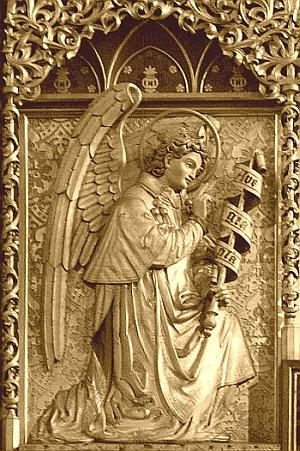 The name means "hero of God." Gabriel is one of the two highest-ranking angels in Christian, Jewish, and Islamic lore, and is usually the chief ambassador to humanity. He is the angel of annunciation, resurrection, mercy, vengeance, death, and revelation. He and Michael are the only angels mentioned by name in the Old Testament (namely, the book of Daniel). Gabriel presides over Paradise and is said to sit on the left-hand side of God. In Jewish legend, Gabriel is the angel of judgment, who rained death and destruction on Sodom and Gomorrah, wrestled with Jacob, and later saved Daniel's friends from the fiery furnace. In Daniel 8:16ff, Daniel falls on his face before Gabriel. In rabbinic literature, Gabriel is the prince of justice. In Christianity, Gabriel is the angel of mercy. There is some confusion about Gabriel and the Holy Ghost in Christian writings, since in Matthew 1:20, the Holy Ghost gets Mary with child, while in Luke 1:26, it is Gabriel who "came in unto her." There are innumerable paintings of Gabriel as the angel who tells Mary that she is pregnant. According to Milton, in Paradise Lost, Gabriel is chief of the angelic guards above Paradise. In Islam, Gabriel (Jibril in Arabic) is the angel of truth, who dictated the Koran to Mohammed on the Night of Power, and his wings stretched from east to west. An Islamic legend derived from the Quran (sura 20, 88) says that dust from the hooves of Gabriel's horse was thrown into the mouth of the Golden Calf and magically animated it. Joan of Arc (not to be confused with Noah of the ark) said that it was Gabriel who inspired her to fight for the king of France.
The name means "hero of God." Gabriel is one of the two highest-ranking angels in Christian, Jewish, and Islamic lore, and is usually the chief ambassador to humanity. He is the angel of annunciation, resurrection, mercy, vengeance, death, and revelation. He and Michael are the only angels mentioned by name in the Old Testament (namely, the book of Daniel). Gabriel presides over Paradise and is said to sit on the left-hand side of God. In Jewish legend, Gabriel is the angel of judgment, who rained death and destruction on Sodom and Gomorrah, wrestled with Jacob, and later saved Daniel's friends from the fiery furnace. In Daniel 8:16ff, Daniel falls on his face before Gabriel. In rabbinic literature, Gabriel is the prince of justice. In Christianity, Gabriel is the angel of mercy. There is some confusion about Gabriel and the Holy Ghost in Christian writings, since in Matthew 1:20, the Holy Ghost gets Mary with child, while in Luke 1:26, it is Gabriel who "came in unto her." There are innumerable paintings of Gabriel as the angel who tells Mary that she is pregnant. According to Milton, in Paradise Lost, Gabriel is chief of the angelic guards above Paradise. In Islam, Gabriel (Jibril in Arabic) is the angel of truth, who dictated the Koran to Mohammed on the Night of Power, and his wings stretched from east to west. An Islamic legend derived from the Quran (sura 20, 88) says that dust from the hooves of Gabriel's horse was thrown into the mouth of the Golden Calf and magically animated it. Joan of Arc (not to be confused with Noah of the ark) said that it was Gabriel who inspired her to fight for the king of France.
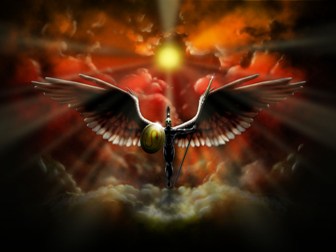
Metatron
Conclusions
Angelology had its heyday in the late Middle Ages, roughly from 1100 through the 1300s. Once the Renaissance bloomed, the New World was discovered, and the spiritual was replaced by the scientific, people no longer believed that the sun and moon and planets were angels, nor that they were kept in motion by angels. Angelology faded, replaced by invention and discovery. But angels remained with us, at least in Western cultures. Museums are full of paintings and sculptures of angels from almost every decade. In the late 1800s, Rudolf Steiner proposed a new hierarchy of angels, completely ignoring the orthodox one. Angels continued to appear in popular songs ("Teen Angel," say), on wedding invitations, and atop Christmas trees (ask me why sometime). Angels are sold today as souvenirs, jewelry, religious and semi-religious bric-a-brac, and snow-globes. They show up surprisingly often in the entertainment media, with TV shows and movies based on angelic rescues. It's a Wonderful Life continues to be a popular movie at Christmas time. To be sure, the treatment of angels today is largely insipid - Sophy Burnham says, "both simpering and dogmatic simultaneously." I say, let's have an Old Testament cherub eat the cast of Touched by an Angel for a snack.
Resources:
Most of this material is taken from A Dictionary of Angels by Gustav Davidson (The Free Press, NY, 1967). It's a wonderful reference book if you need any information about historical angels. We have quoted and paraphrased liberally from Davidson's amazing compendium, and we here give due recognition and acknowledgement.
Other resources include: A Book of Angels, by Sophy Burnham, Ballantine Books, NY, 1990
Angels, An Endangered Species, by Malcolm Godwin, Simon & Schuster, NY, 1990
— Dex
Source Here
Liked this article? Dive deeper into personal growth and wellness! Check out CrystalWind.ca for spiritual wisdom or explore AromaWorx.ca for natural well-being tips. Spread the positivity—share this with friends on their happiness journey!
Let’s Chat! Drop Your Thoughts Below! ![]()
Latest Articles

Imagine a world of inspiration and healing, free for all—made possible by YOU!
Donate Now—Ignite the Magic at CrystalWind.ca!

Epilepsy - Finding A Cure
Your donation can make a difference!
Help us find a cure – donate now!
Unlock Your Light: Join Lightworkers Worldwide on CrystalWind.ca!
Articles: Calling All Angels
Follow Us!
Featured This Month
The Vine: September 2nd - September 29th
The Autumnal Equinox ( Alban Elfed ) Celtic Symbol : The White Swan Read more
Sun in Virgo
An Overview of Sun Sign Characteristics for Virgo Virgo is guided by Mercur... Read more
Crystals for Virgo
As the warmth of summer begins to soften into the crispness of autumn, the Sun... Read more
Mabon Magic: Ideas For Fall Decoration And R…
Welcome (almost!) to Fall! We’re turning the Great Wheel once again, toward ... Read more
Watermelon Tourmaline
Synonym: Rainbow Tourmaline The watermelon tourmaline is a rare variety t... Read more
Sweet Violet
Sweet Violet Faithfulness and modesty. “I will always be true to you.” Helps... Read more
Mabon in Modern Times: Fresh Takes on the Au…
The Mabon season begins somewhere around the 21st-22nd of September and cont... Read more
Peridot: The Healer's Stone
Peridot has been used as a Power Stone for centuries. Peridot fosters emotio... Read more
Virgo Mythology
The Virgo Myth In all of constellation mythology, few legends are as misund... Read more






























































































































































